Gas Vapor Regulations: The Legislature’s Decentralized Approach Neither Requires nor Produces Consistency, and Current Regulations May Be Requiring Outdated Technology
Preliminary Report, December 2014
Gasoline vapors that escape when fueling motor vehicles pose a risk to health and the environment. In Washington, the state Department of Ecology and seven local clean air agencies share primary responsibility for regulating air quality, including gasoline vapors. Twenty-five other states also take a decentralized approach to regulating air quality.
Businesses that emit gasoline vapors, such as gas stations, may be required to register with the local agency and pay a fee. Each agency determines its fees. The fees vary across agencies. The fee-setting process each uses complies with statute.
A type of gasoline vapor recovery system (Stage II) that many Washington gas stations are required to use may be outdated because of a vapor recovery system that is now installed in cars. In fact, interaction between two types of incompatible systems can actually increase emissions. The Environmental Protection Agency (EPA) provides guidance to help states analyze when the use of these systems at gas stations will begin to increase gas vapor emissions. The Legislative Auditor recommends that the Department of Ecology and the local clean air agencies undertake and publish this analysis to avoid increasing gas vapor emissions.
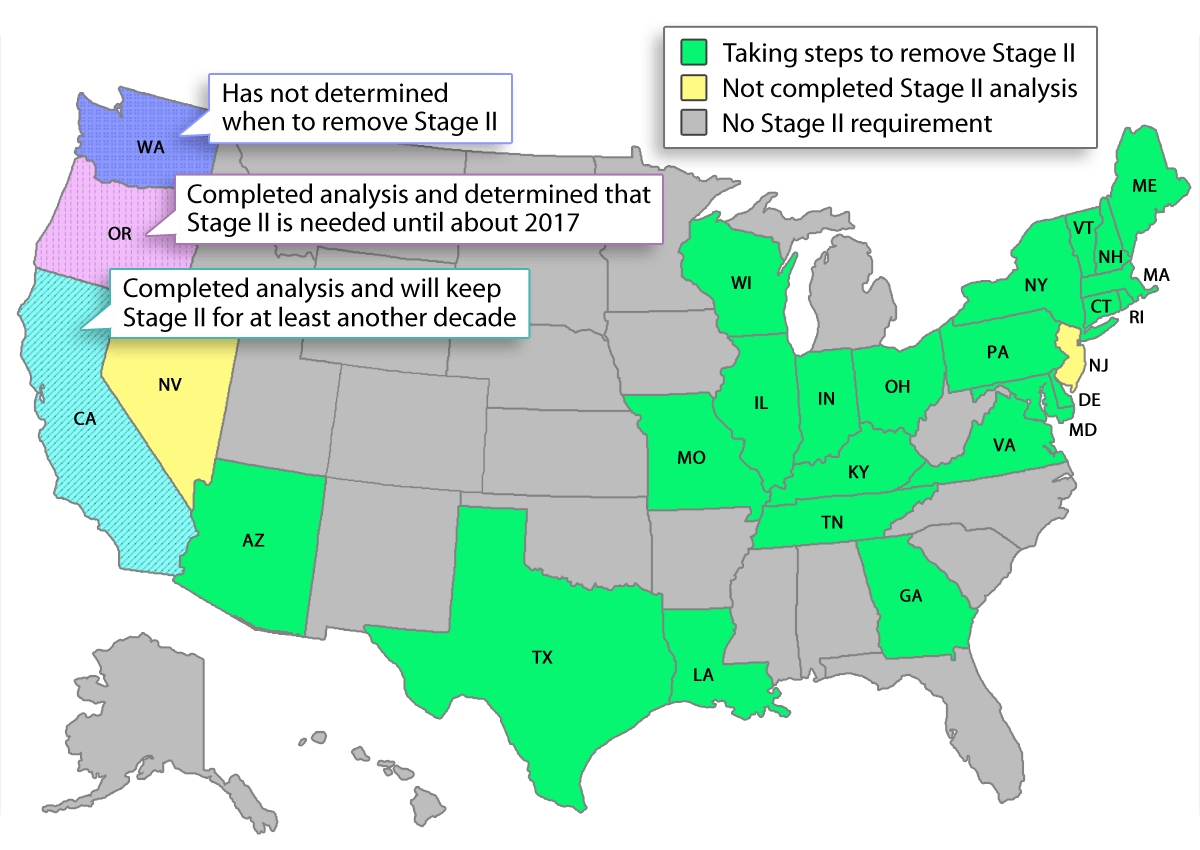
Twenty-two states taking steps to remove Stage II
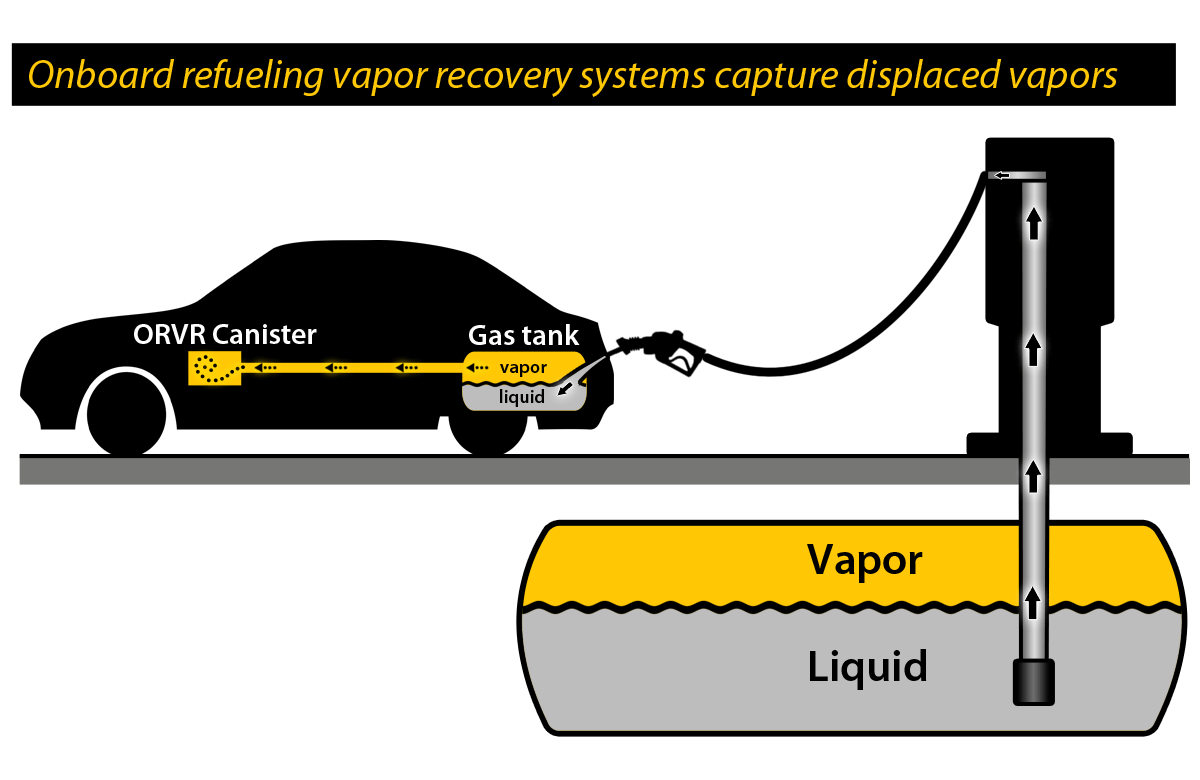
With Onboard Refueling Vapor Recovery (ORVR) systems, motor vehicles capture gasoline vapors displaced during refueling
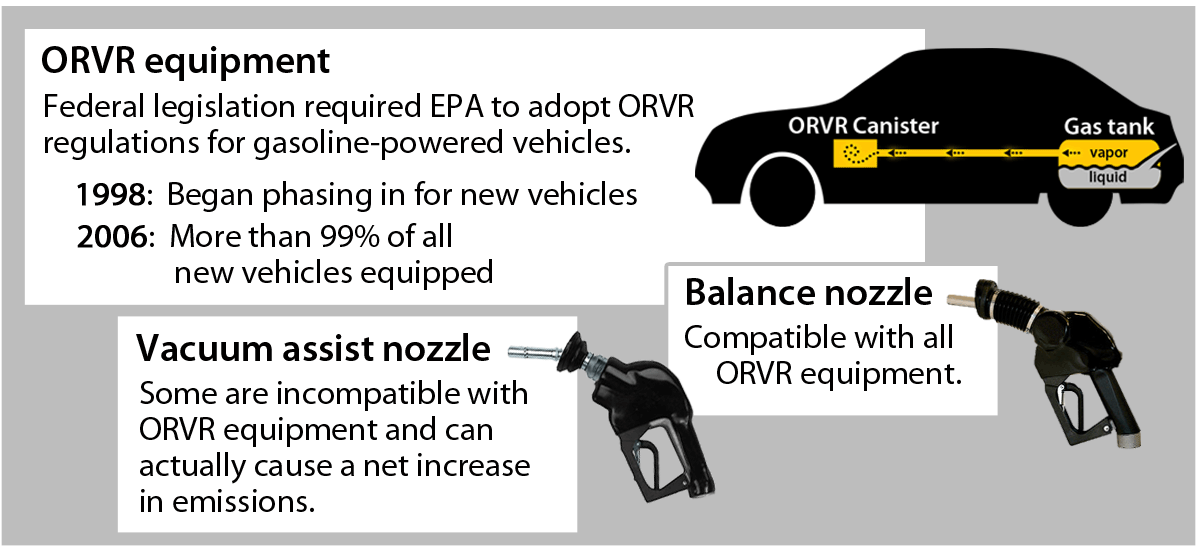
Vacuum assist nozzles can cause a net increase in emissions
Friendly
In Brief
- The state Department of Ecology and seven local clean air agencies share responsibility for regulating gasoline vapor emissions in Washington.
- The fees the local agencies set vary. The fee-setting process each uses complies with statute.
- Gasoline station inspection processes are similar among the local agencies. The frequency of the inspections varies.
- Interactions between two incompatible types of systems can actually increase emissions.
Legislative Auditor Recommends:
-
Do analysis to avoid increasing emissions
Many gas stations in Washington are required to install vapor recovery systems on their dispensers. This system is known as “Stage II.”
Auto manufacturers began installing vapor recovery systems on motor vehicles in 1998. According to the federal Environmental Protection Agency (EPA), the system in vehicles is cheaper and more effective at capturing gasoline vapor than Stage II systems at gas stations. Since more than 99 percent of new gasoline-powered vehicles have these systems, the Stage II system is increasingly redundant. Importantly, the interaction between some Stage II systems and the system in newer vehicles can actually increase emissions.
The EPA has provided guidance to help states determine when Stage II requirements will begin to increase emissions, given the increasing prevalence of newer vehicles. Twenty-two of the 27 states that once required Stage II systems to meet the federal ozone standard have taken steps to remove this requirement.
In Washington, Stage II systems are currently required at more than 1,300 gas stations to help Puget Sound Clean Air Agency and Southwest Clean Air Agency meet the federal ozone standard.
The JLARC staff analysis using EPA guidance estimates that Stage II requirements are already providing minimal emission reductions and could begin to increase emissions as soon as 2020 in Southwest and Puget Sound jurisdictions.
Staff at Southwest completed the analysis in 2012 and determined that removing Stage II systems would not interfere with meeting the federal ozone standard.
Staff at Puget Sound completed two analyses in September 2014 and determined that Stage II requirements are needed until 2023 and possibly beyond 2030. One analysis used factors that do not represent the Stage II systems in Puget Sound’s jurisdiction. Their other analysis relied on EPA’s guidance document, but used factors not recommended by EPA.
The Department of Ecology has yet to analyze whether to remove Stage II requirements.
The Department of Ecology and the local clean air agencies should estimate and publish when Stage II requirements will begin to increase emissions. This analysis should determine whether keeping Stage II systems helps the regions meet EPA’s current ozone standard and the costs and cost effectiveness associated with keeping these systems.Legislation Required: No Fiscal Impact: Ecology staff estimate it would take 2 months of staff time Implementation Date: March 1, 2015
Study included stakeholder input
-
Mandate in Transportation Budget
In the 2013-15 Transportation Budget (ESSB 5024), the Legislature directed JLARC to conduct a study of the registration and inspection fee programs regulating gasoline stations and other businesses that emit gasoline vapors. This study focuses on gas stations.
ESSB 5024 also directed JLARC staff to hold stakeholder meetings with representatives from each clean air regulatory agency, from the Washington Oil Marketers Association, and from other industry associations or groups. The stakeholder meetings were held in April 2014.
During the meetings, industry stakeholders expressed concerns about variability in practices, policies, and fees, as well as with the transparency of the local clean air agencies in their processes that affect gasoline stations. Additionally, industry stakeholders expressed concerns that Washington was still requiring a type of vapor recovery system (Stage II) at gas stations that they believed was no longer needed.
Staff from the regulatory agencies offered the perspective that the variability of the fees and regulations are the result of locally controlled jurisdictions responding to the problems unique to their regions using principles adopted by their boards.
State and local agencies share responsibility for regulating gasoline vapors
Gasoline vapor emissions in most areas in Washington are regulated by either the state Department of Ecology or one of seven local clean air agencies.
-
Washington: decentralized approach
Gasoline vapors emit volatile organic compounds that lead to the production of ground-level ozone. Ozone is the main component of smog and has been found to be harmful to human health and natural ecosystems. Gasoline vapors also contain benzene, which the EPA has classified as a hazardous air pollutant.
Washington has chosen a decentralized approach to air quality regulation. The Washington Clean Air Act (Chapter 70.94 RCW) allows locally elected officials to create a local clean air agency. These agencies may cover one or more counties. The agencies are governed by a board of directors that include locally elected officials.
There are currently seven local clean air agencies in Washington (Exhibit 1). The local agencies range in size from four to more than 70 employees. The Department of Ecology regulates any counties without a local clean air agency. Tribal governments work with the EPA on air quality for lands within reservation boundaries.
Exhibit 1 - The Department of Ecology and Seven Local Clean Air Agencies Regulate Gasoline Vapors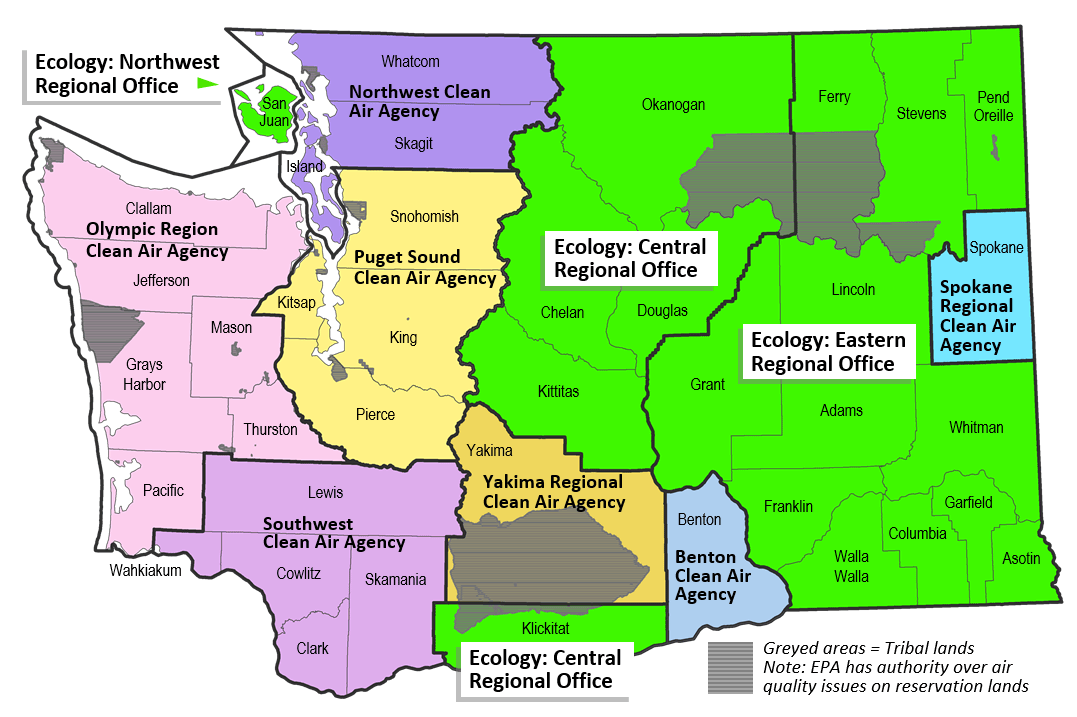 Source: Department of Ecology.
Source: Department of Ecology.While this study focuses on the regulation of gas stations, local clean air agencies are responsible for regulating any business that has the potential to emit air pollutants. Each local clean air agency identified air quality issues of particular concern to their area. For example, the Benton Clean Air Agency says it emphasizes regulating dust and field burning. The Yakima Regional Clean Air Agency reports it focuses on woodstove smoke because air tends to settle in the Yakima Valley region. The Puget Sound Clean Air Agency expressed concerns with smog because their jurisdiction has a higher density of motor vehicles.
-
25 other states also decentralized
The federal Clean Air Act gives states flexibility in how to organize themselves to meet the Act’s requirements. Washington has chosen a decentralized approach. Twenty-five other states have also chosen a more decentralized approach to regulating air quality. Eighteen states have between one and three local agencies. Seven other states have four or more local agencies.
Fees vary across local agencies, and agency fee-setting processes comply with statute
Businesses that emit gasoline vapors, including gas stations, may be required to register with their local agencies and pay a fee.
-
Agencies set their own fees
Each local agency goes through a process with its board to set fees for the area, including fees for gas stations.
State statute requires that fees paid to clean air agencies may only be used to pay for the costs of administering the registration program. Administration can include:
- Initial registration, annual registration, or other periodic reports;
- On-site inspections;
- Data storage and retrieval systems;
- Emission inventory reports;
- Engineering analyses that evaluate the effectiveness of air pollution control strategies; and
- Clerical or other office support that directly relates to carrying out the registration program.
The State Auditor’s Office conducts accountability or financial audits of the seven local clean air agencies at least every two years. JLARC staff reviewed SAO audits of the local agencies back to 2007. There were no audit findings regarding any of the agencies’ registration programs and the use of the fees to administer the programs. If SAO believes there is a risk, these audits also check that agencies comply with state laws, such as Washington’s Administrative Procedure Act and Open Public Meetings Act. There were no findings in the time period JLARC staff reviewed.
-
Fee basis and amount varies
As allowed by statute, the methodologies used by local clean air agencies to calculate the fees for their registration programs vary. As shown in Exhibit 2 below, fees are either a flat fee per business, based on the amount of gasoline dispensed, or based on the number of underground storage tanks.
Exhibit 2 – Gas station fees and fee methodologies vary among the agenciesClean Air Agency How are Fees Calculated? In 2013: # of Gas
StationsAverage
FeeFee
RangePuget Sound Gasoline dispensed 1,300 $713 $140 to $4,085 Southwest Gasoline dispensed multiplied by an emission factor(s) 334 $332 $0 to $3,489 Olympic Region Fixed fee 292 $251 $240 or $600 Spokane Regional Fixed fee plus gasoline dispensed multiplied by an emission factor(s) 172 $601 $276 to $2,340 Northwest Gasoline dispensed 166 $919 $0 to $4,715 Yakima Fixed fee 103 $439 $439 Benton County Gasoline dispensed 74 $525 $200 to $4,093 Ecology Number of underground storage tanks 416 $0 Currently $0 Source: JLARC staff analysis of agency fees.Another factor that can result in variation among the fees is the extent to which agencies cover costs to administer their registration programs. This factor is discussed in the methodology section below.
These methodologies are also consistent with the guidance the U.S. Government Accountability Office (GAO) provides to agencies when setting fees. GAO provides four criteria to use when determining fees: efficiency, equity, revenue adequacy, and administrative burden.
GAO notes that these criteria can often interact with one another and at times can conflict with each other. As such, policymakers must consider the tradeoffs among the criteria and recognize that no single fee design will satisfy everyone on all dimensions. For example, a fee that does not fully recover the costs of administering its program may not be the most equitable because it would require other entities to subsidize the costs.
-
Methodology for determining fees:
-
Puget Sound Clean Air Agency
Puget Sound bases its fees on the amount of gasoline dispensed by a gas station each year. This approach has not changed since the agency developed it in 2003. The agency last raised fees in 2013. Agency staff determined that the amount of gasoline dispensed at a gas station was a good proxy for emissions and agency workload.
Puget Sound has had a policy of recovering the costs of its registration program since 1991. The Agency also has a policy of maintaining a reserve balance of about 25 percent of the annual cost of the program to protect against unforeseen costs. Staff report the Agency expects to meet this target for FY 2015.
In 2013, there were 1,300 gas stations in Puget Sound’s jurisdiction. The average fee was $713. In addition to these fees, gasoline station owners must pay certified contractors about $300 per test to have their Stage II system tested. These tests are required once every six months.
-
Southwest Clean Air Agency
Southwest bases its fees on a polluter-pays concept, which means that a gas station with higher emissions pays a higher fee. This also means that the type of emissions system installed at a gas station will impact the fee amount. For example, two gas stations that dispense the same amount of gasoline will be assessed a different fee if their emissions system is different.
When calculating a gas station’s emissions, Southwest does not include the emission reductions that are provided by the vapor recovery systems that are now installed on motor vehicles.
The Agency has not increased fees since 2008. Southwest staff indicated that its registration program is recovering about 50 percent of its costs. As such, the Agency subsidizes the costs of its registration program through grants, per capita assessments, and other fees and revenues. The Agency reports it has also decreased the frequency of its inspections due to staff reductions.
In 2013, there were 334 gas stations in Southwest’s jurisdiction. The average fee was $332. In addition to these fees, gasoline station owners may be required to pay certified contractors about $300 per test to have their Stage II system tested. These tests are required on an annual basis for one type of Stage II system.
-
Olympic Region Clean Air Agency
Olympic Region uses two fixed flat fees based on the gas station's potential emissions. Potential emissions are calculated using standard emission factors, the potential amount of gasoline dispensed, and installed emission control technologies. Gas stations with higher emissions pay the higher fee. This means that the type of emissions system installed at a gas station may impact which fixed flat fee a gas station pays. For example, two gas stations that dispense the same amount of gasoline may pay a different fee if their emissions system is different. Olympic Region decided on this approach because it determined that businesses with more emissions require more staff resources to ensure compliance.
When calculating a gas station’s potential emissions, Olympic Region includes the emission reductions that are provided by the vapor recovery systems that are now installed on motor vehicles.
In 2012, Olympic Region made a policy decision to increase its fees to more fully recover the costs of administering its registration program. Olympic Region staff completed a workload analysis and determined that current fees were only covering about 50 percent of its costs. In FY 2013, the Agency recovered about 99 percent of the costs of administering its registration program. Olympic Region’s regulations require it to complete a new workload analysis every two years.
In 2013, there were 292 gas stations in Olympic Region’s jurisdiction. The average fee was $251. In addition to these fees, gasoline station owners are currently required to pay certified contractors about $300 per test to have their Stage II system tested. These tests are required on an annual basis.
-
Spokane Regional Clean Air Agency
Spokane Regional bases its fees on a polluter-pays concept, which means that a gas station with higher emissions pays a higher fee. This also means that the type of emissions system installed at a gas station will impact the fee amount. For example, two gas stations that dispense the same amount of gasoline will be assessed a different fee if their emissions system is different. Spokane Regional adopted this approach in 2006 to move towards full cost-recovery of its registration program. Fees were increased in 2008, 2009 and 2014.
When calculating a gas station’s emissions, Spokane Regional does not include the emission reductions that are provided by the vapor recovery systems that are now installed on motor vehicles.
In FY 2013, Spokane Regional recovered about 82 percent of the costs of administering its registration program.
In 2013, there were 172 gas stations in Spokane Regional’s jurisdiction. The average fee was $601.
-
Northwest Clean Air Agency
Northwest bases its fees on the amount of gasoline dispensed by a gas station each year. In 2010, the Agency made a policy decision to increases its fees to more fully recover the costs of administering its registration program. To do so, the Agency reviewed fee schedules of other clean air agencies and those in other states. The Agency decided to base gas station fees on a structure used by the Puget Sound Clean Air Agency. Fees for businesses increased, with a proportionately larger increase for gas stations.
In FY 2013, Northwest recovered more than the costs to administer its registration program by about 10 percent. The Agency reports that fees will be adjusted if its program continues to experience a net increase in revenue.
In 2013, there were 166 gas stations in Northwest’s jurisdiction. The average fee was $919.
-
Yakima Regional Clean Air Agency
Yakima Regional uses a fixed flat fee by category of businesses. This means that all gasoline stations pay the same fee regardless of size. The fee amounts are based on average workload. This fee structure has been in place since at least 1999 and was designed to fully recover the costs of the administering the registration program.
In FY 2013, the Agency recovered about 97 percent of the costs of administering its registration program.
In 2013, there were 103 gas stations in Yakima Regional’s jurisdiction. The average fee was $439.
-
Benton County Clean Air Agency
Benton County bases its fees on the amount of gasoline dispensed by a gas station each year. This approach has not changed since the agency developed it in 2005. The Agency determined that it was an equitable approach to assessing fees for gasoline stations because stations that dispense more gasoline require more staff resources to ensure compliance.
In FY 2013, the Agency recovered about 67 percent of the costs of administering its registration program.
In 2013, there were 74 gas stations in Benton County’s jurisdiction. The average fee was $525.
-
The Department of Ecology
Staff from Ecology’s Air Quality Program previously administered a registration and inspection program for gas stations in counties without local air agencies. Ecology discontinued its program in 2002 following budget reductions. If the program is re-established, Ecology indicates it plans to assess a fee of $130 for each underground storage tank that is located at a gasoline station.
Ecology reports it does not expect to restart its program until late in 2015, at the earliest. Before restarting this program and making other changes to its regulation of gas stations, Ecology will have to adopt new rules. Unlike local clean air agencies, Ecology is required to prepare a cost-benefit analysis before adopting a significant legislative rule under the Washington Administrative Procedure Act.
There are 416 gas stations in Ecology’s jurisdiction.
-
Gasoline station inspection processes are similar, but frequency of inspections varies
The Washington Clean Air Act allows Ecology and the local clean air agencies to conduct on-site inspections of air contaminate sources, including gasoline stations. Inspections are conducted to verify compliance with registration requirements.
-
Inspection processes similar
Two Washington clean air agencies have not been conducting inspections. Six agencies visually inspect equipment at gas stations to ensure it is working properly. For example, agency staff will check if the nozzles or hoses at gas stations are cracked or kinked. If they are, this equipment may have the potential to release gasoline vapors.
For agencies that conduct inspections, the steps can be summarized into three activities: pre-inspection activities, the on-site inspection, and post-inspection activities.
Pre-inspection activities
During pre-inspection activities, agency staff review previous inspections and permits for the gasoline station and check to ensure any compliance issues have been resolved from a prior inspection.
On-site inspection
During an inspection, staff ensure gasoline stations are complying with their permits and any applicable regulations. The following steps are included in an on-site inspection:
- Meet with on-site employees at the gasoline station and verify gasoline equipment;
- Check self-reporting and record keeping information;
- Inspect gas vapor recovery systems; and
- Inform attendant of results of inspection and follow-up with any concerns.
Post-inspection activities
After the on-site inspection is completed, agency staff update their records and send the business the results of the inspections. Agency staff also follow up to ensure any issues discovered during the inspection are corrected.
In comparison to inspections, testing is conducted by certified testers and detects whether gas vapors are escaping. The Puget Sound Clean Air Agency, Olympic Region Clean Air Agency, and Southwest Clean Air Agency require testing of Stage II systems after the system has been installed. These tests are not covered by the registration fee and cost about $300 per test. The testing requires businesses to shut down for approximately 45 minutes.
The Petroleum Equipment Institute recommends that Stage II systems be tested annually to ensure effective operation.
-
Inspection frequency varies
Each agency determines how frequently to conduct inspections, if at all (Exhibit 3).
The frequency of agency inspections varies from once a year to once every five years. Staff at agencies that conduct annual inspections assert that it is important to ensure that a gas station’s vapor recovery system is properly operating. The Southwest Clean Air Agency reports that it inspects stations once every five years due to staff reductions.Exhibit 3 - Each Agency Determines Frequency of InspectionsAgency Inspection Frequency Puget Sound Currently, about 20% of gas stations are inspected annually and Stage II systems are tested every six months Southwest Every five years and one type of Stage II system is tested annually Olympic At least once every two years and Stage II systems are currently tested annually Spokane Annually, but staff are usually only able to inspect 80-85% of stations Northwest Annually Yakima Higher dispensing stations: annually
Medium stations: every other year
Small stations: every three yearsBenton Program restarted in October 2014 and inspections will occur once every two years Ecology Not currently conducted Source: JLARC staff interviews of agency staff.
Agencies should analyze the extent to which old requirements conflict with new technology
The interaction between some Stage II systems at gas stations and the gas vapor recovery system installed by automobile manufacturers in newer vehicles can actually increase gas vapor emissions.
-
Stage II becoming redundant
There are three types of vapor recovery systems used to minimize vapor emissions during the transfer of gasoline at a gas station.
Stage I vapor recovery systems are used during the transfer of gasoline from a tanker truck to a gasoline station’s underground storage tank. Gas stations that meet specific criteria for amount of gasoline dispensed are required by EPA to use Stage I controls.
Exhibit 4 – With Stage I systems, tanker trucks capture gasoline vapors displaced during the transfer of gasoline to underground storage tanks Source: JLARC staff review of Stage I vapor recovery systems.
Source: JLARC staff review of Stage I vapor recovery systems.Stage II vapor recovery systems are used during the refueling of motor vehicles and are installed on gas station dispensers.
Exhibit 5 – With Stage II systems, underground tanks capture gasoline vapors displaced during refueling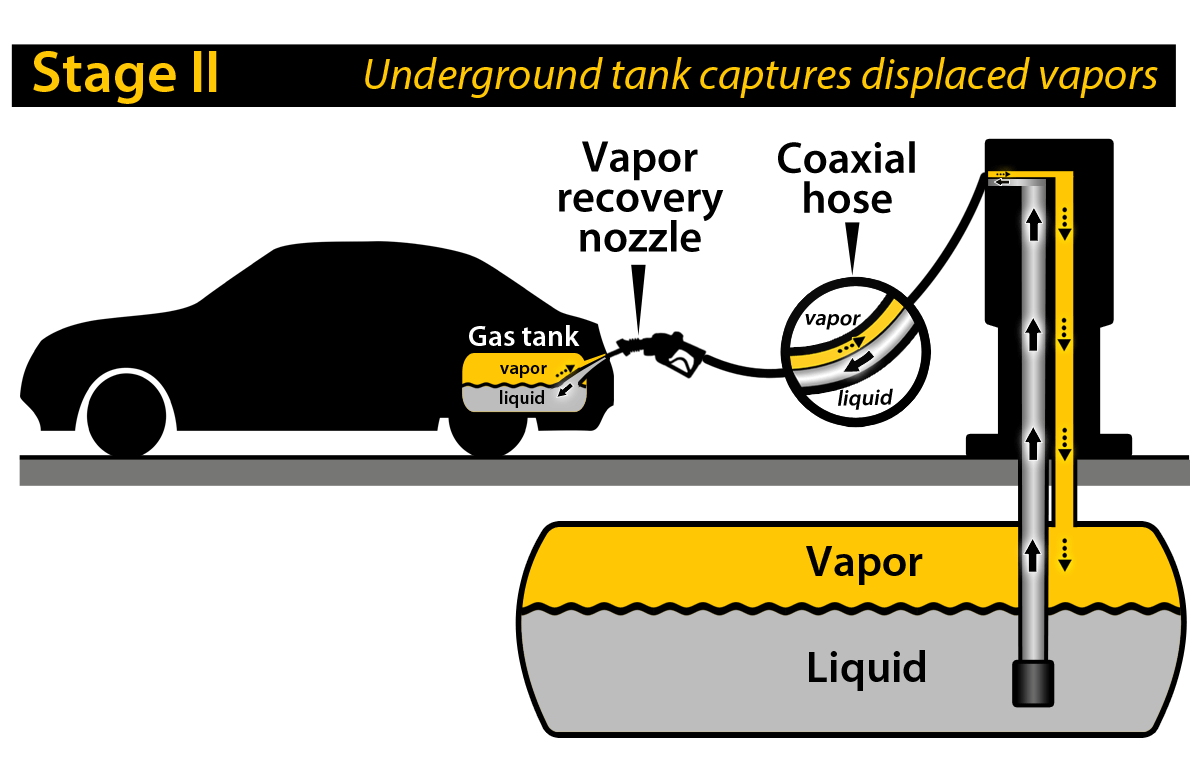 Source: JLARC staff review of Stage II vapor recovery systems.
Source: JLARC staff review of Stage II vapor recovery systems.Like Stage II systems, Onboard Refueling Vapor Recovery (ORVR) systems also capture gasoline vapors during the refueling of vehicles. These systems are installed by automobile manufacturers inside the motor vehicle tank.
Exhibit 6 – With ORVR systems, motor vehicles capture gasoline vapors displaced during refueling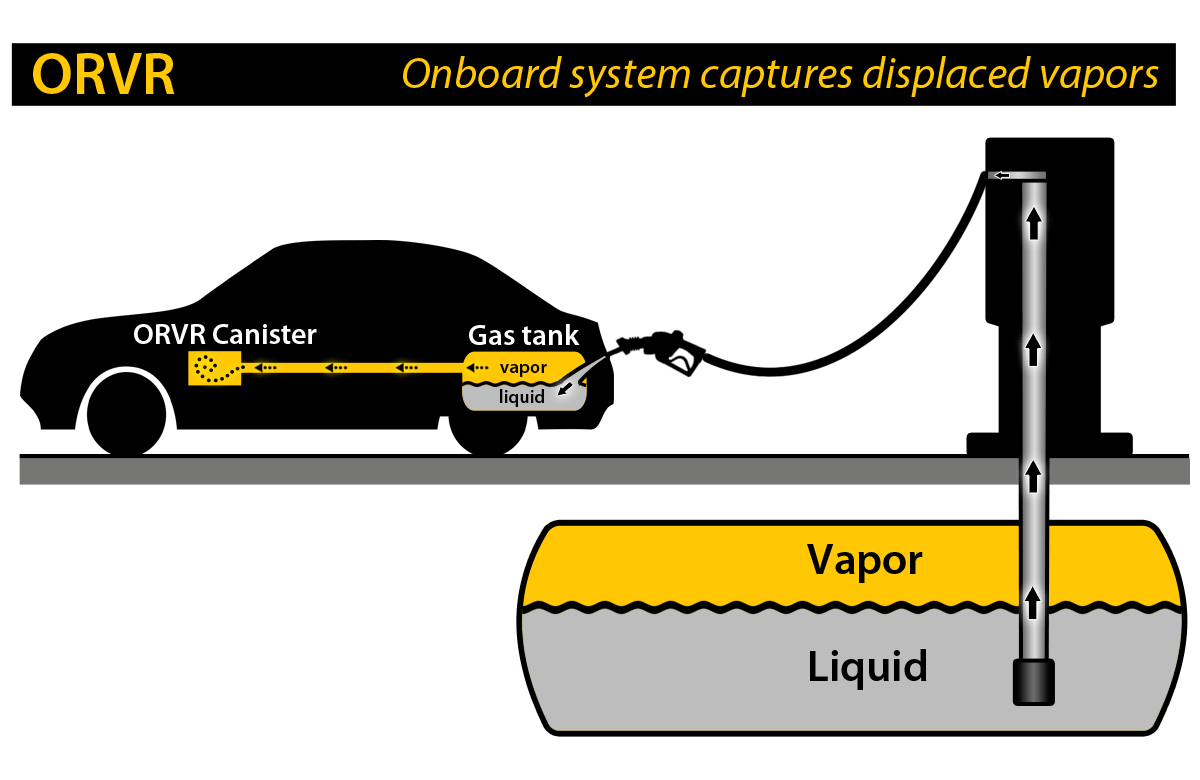 Source: JLARC staff review of Onboard Refueling Vapor Recovery (ORVR) systems.
Source: JLARC staff review of Onboard Refueling Vapor Recovery (ORVR) systems.Federal legislation required EPA to adopt ORVR regulations. This system was phased in for new vehicles beginning in 1998. The EPA has stated that ORVR is more effective at capturing gasoline vapors and also less expensive than Stage II vapor recovery systems.
-
Feds no longer require Stage II
Amendments to the federal Clean Air Act in 1990 mandated that certain jurisdictions require gas stations to install Stage II vapor recovery systems. These jurisdictions included the Puget Sound and Southwest Clean Air Agencies in Washington. Subsequent legislation in 1994 removed this federal Stage II requirement. However, Puget Sound and Southwest Clean Air Agencies still had to meet the federal ozone standards and retained Stage II requirements to help their regions meet these standards.
In May 2012, the EPA determined that Stage II systems were achieving an ever-declining benefit as more vehicles on the road were equipped with Onboard Refueling Vapor Recovery (ORVR) systems. This determination allowed, but did not require, states to remove Stage II requirements. Any state changes to Stage II requirements are conditioned on approval by the EPA. Additionally, the EPA found that emissions might actually increase due to incompatibility between certain Stage II systems and ORVR.
Additionally, all of the local clean air agencies and Ecology have Stage II requirements for certain gas stations based on the amount of gasoline dispensed and proximity to residential areas as a way to address concerns with toxic compounds. EPA acknowledges that states can retain these controls to address these concerns. This requirement currently impacts no more than 20 of the more than 2,800 gas stations in Washington.
-
Many states removing Stage II
In 1990, jurisdictions in 27 states required Stage II systems at gas stations. As shown in Exhibit 7, 22 of these 27 states have since taken steps to remove this requirement.
EPA estimates that the cost to install Stage II systems at new gas stations ranges from $20,000 to $60,000. EPA also estimates that owners pay approximately $3,000 dollars per year for maintenance costs.
Exhibit 7 - Twenty-two states taking steps to remove Stage II requirements from 1990 Source: JLARC staff review of other states Stage II requirements.
Source: JLARC staff review of other states Stage II requirements.California completed its analysis and reports it will keep Stage II requirements for at least another decade because most of its gas stations have Stage II systems that are compatible with the systems installed on cars. Oregon has completed its analysis and determined that Stage II requirements are needed until about 2017. It has not taken any action to remove Stage II. Nevada and New Jersey have yet to determine when Stage II requirements will no longer be needed.
-
WA Stage II removal date undetermined
Using the EPA’s guidance document, JLARC staff estimate that Stage II systems are already providing minimal emission reductions and could begin to increase emissions as soon as 2020 in the jurisdictions of Southwest Clean Air Agency and Puget Sound Clean Air Agency.
Staff at the Southwest Clean Air Agency completed the analysis in 2012 and concluded that removing Stage II requirements would not interfere with meeting the current ozone standard. Additionally, the analysis estimated that removing Stage II systems in 2014 would increase emissions by less than 0.3% and would not begin to increase emissions until about 2020. However, the analysis was not shared with Southwest’s Board or published.
Staff at the Puget Sound Clean Air Agency completed two analyses in September 2014. One analysis used factors that do not represent the Stage II systems in Puget Sound’s jurisdiction. The other analysis relied on EPA’s guidance document, but used factors not recommended by EPA and stated the technology compatibility issue was beyond the scope of their analysis. Staff determined that both analyses support keeping Stage II requirements until at least 2023, and possibly beyond 2030.
The Department of Ecology has yet to analyze whether or not to remove Stage II requirements. The agency cannot say when staff may be able to complete the analysis. Ecology staff estimate it would take two months of staff time to do so. Ecology staff also expressed concerns about undertaking the analysis until after the EPA revises it ozone standards in late 2014. Based on conversations with the EPA and other states, the Stage II analysis is independent from the new ozone standard.
Legislative Auditor Recommendation
The Department of Ecology and the local clean air agencies should estimate and publish when Stage II requirements will begin to increase emissions. This analysis should determine whether keeping Stage II systems helps the regions meet EPA’s current ozone standard and the costs and cost effectiveness associated with keeping these systems.
Agency response(s) will be included in the final report, planned for January 2015.
Contact
Authors of this Study
Zane Potter, Project Lead, 360-786-5194
Eric Thomas, Research Analyst, 360-786-5182
Valerie Whitener, Audit Coordinator
Keenan Konopaski, Legislative Auditor
Joint Legislative Audit and Review Committee
Eastside Plaza Building #4, 2nd Floor
1300 Quince Street SE
PO Box 40910
Olympia, WA 98504-0910
Phone: 360-786-5171
FAX: 360-786-5180
Email: JLARC@leg.wa.gov
Audit Authority
The Joint Legislative Audit and Review Committee (JLARC) works to make state government operations more efficient and effective. The Committee is comprised of an equal number of House members and Senators, Democrats and Republicans.
JLARC’s non-partisan staff auditors, under the direction of the Legislative Auditor, conduct performance audits, program evaluations, sunset reviews, and other analyses assigned by the Legislature and the Committee.
The statutory authority for JLARC, established in Chapter 44.28 RCW, requires the Legislative Auditor to ensure that JLARC studies are conducted in accordance with Generally Accepted Government Auditing Standards, as applicable to the scope of the audit. This study was conducted in accordance with those applicable standards. Those standards require auditors to plan and perform audits to obtain sufficient, appropriate evidence to provide a reasonable basis for findings and conclusions based on the audit objectives. The evidence obtained for this JLARC report provides a reasonable basis for the enclosed findings and conclusions, and any exceptions to the application of audit standards have been explicitly disclosed in the body of this report.
JLARC Members on Publication Date
Senators
Randi Becker
John Braun, Vice Chair
Annette Cleveland
David Frockt
Janéa Holmquist Newbry
Jeanne Kohl-Welles, Secretary
Mark Mullet
Ann Rivers
Representatives
Cathy Dahlquist, Asst. Secretary
Tami Green
Kathy Haigh, Chair
Ed Orcutt
Gerry Pollet
Derek Stanford
J.T. Wilcox
Hans Zeiger
Scope & Objectives
Why a JLARC Study of Gasoline Vapor Regulation?
In the 2013-2015 Transportation Budget (ESSB 5024), the Legislature directed the Joint Legislative Audit and Review Committee (JLARC) to conduct a study of the registration and inspection fee programs regulating gasoline stations and other businesses that may emit gasoline vapors. The Legislature indicated its interest in consistent and transparent registration fees and regulations across the agencies that regulate these businesses.
State and Local Agencies Share Responsibility for Regulating Gasoline Vapor Emissions
The federal Clean Air Act (the Act) calls for state, local, and tribal governments to implement the Act in partnership to reduce air pollution. Air quality in most areas in Washington is regulated by either the Department of Ecology (Ecology) or one of seven local clean air agencies (see Exhibit 1 on the next page). Tribal governments work with the U.S. Environmental Protection Agency on air quality for lands within reservation boundaries.
The Washington Clean Air Act (Chapter 70.94 RCW) allows Ecology and local clean air agencies to determine and classify sources of air contamination, including gasoline vapors, that may cause or contribute to air pollution. Ecology and the local agencies may require businesses that emit gasoline vapors to register with and report to the agency. Ecology and the local agencies may also require businesses to employ techniques to limit gasoline vapor emissions. This can include vapor recovery systems, which help capture gasoline vapors during the transfer of gasoline such as when a person refuels a car.
Businesses that register may pay a fee, and each agency determines the amount of the fee it collects. Statute requires that the amount of the fee is only to compensate for the costs of administering the registration/reporting program, which may include on-site inspections. Ecology and the local clean air agencies currently regulate more than 2,700 gasoline dispensing facilities.
Study Objectives
This study will address the following five questions related to gasoline vapor regulation:
- How do registration and inspection processes and criteria compare and contrast among Ecology and the local agencies?
- How do the registration and inspection fees and the methodologies used in calculating fees compare and contrast among Ecology and the local agencies?
- Are fees limited to the costs of administering each agency’s registration/reporting program?
- How do registration and inspection processes and criteria used in Washington compare and contrast with the criteria established by the U.S. Environmental Protection Agency?
- How does Washington’s approach to regulating gasoline vapors compare to approaches taken by other states?
The Department of Ecology and Seven Local Clean Air Agencies Regulate Gasoline Vapors
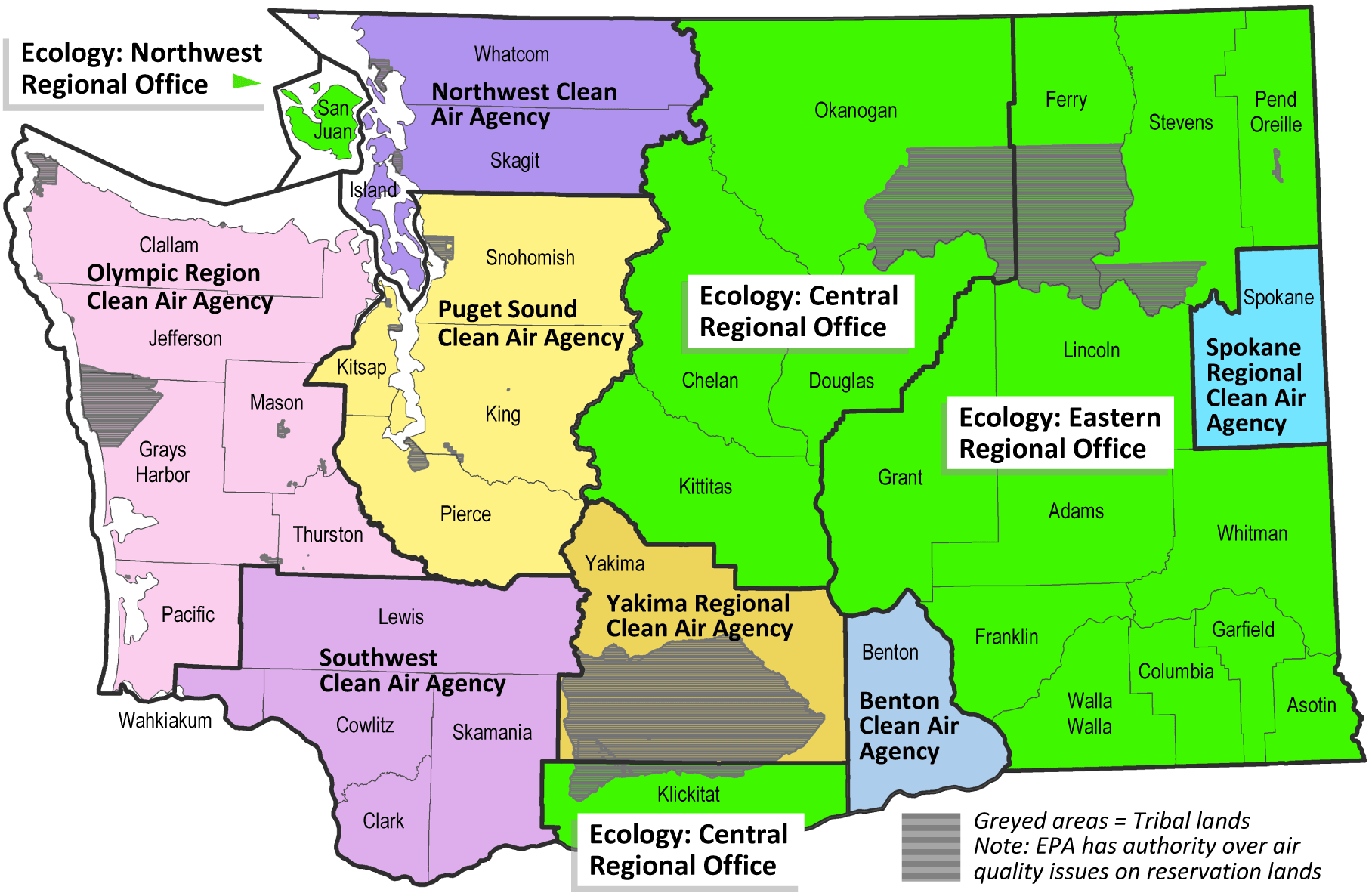
Timeframe for the Study
Statute directs JLARC staff to hold stakeholder meetings and these will be held in April. Staff will present the preliminary report at the December 2014 JLARC meeting and the final report at the January 2015 meeting.